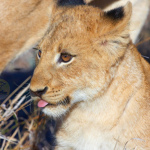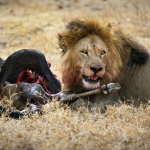Tree Climbing Lions in Uganda: Unique Safari Experience.
There are wonders in this world that exist in the heart of Africa: tree-climbing lions. Unlike other regions on the continent, these lions have adapted to some rare behavior such as climbing and relaxing in tall tree branches. When visiting Uganda, one can get up close to observe this rare natural occurrence-which will surely be among the most indelibly etched moments of the safari. This article explores where to trek tree-climbing lions in Uganda, the reasons behind their tree-climbing behavior, and tips for experiencing this adventure.
Where to Trek the Tree Climbing Lions in Uganda?
The southern area of Queen Elizabeth National Park is home to what can be considered the best place to track tree-climbing lions in Uganda: the Ishasha Sector. It is best recognized for its tree-climbing lion population, one of those special attractions that draws game lovers from all parts of the world. While Queen Elizabeth National Park boasts a wide variety of wildlife, among the most renowned are the lions of Ishasha because of the behaviors they exercise while lounging in the branches of fig and acacia trees.
The Ishasha Sector is often the quietest and the least visited part of the park; this makes it almost an intimate, tranquil, and very personal experience with nature. You will be driving through the open savannahs and riverine forests while observing these magnificent creatures perched up in trees, resting from the day’s heat and surveying the landscape for their prey.
Why Do Lions Climb Trees in Ishasha?
Unlike most lions, which remain on the ground, lions in Uganda climb trees for several reasons. Though the cause is not exactly found out, the following are the current leading theories:
Escaping Heat: The equatorial land of Uganda is very hot during the day, especially in the savannahs. The lions might go up the trees to get off the searing heat on the ground and cool breezes with shades from tree canopies.
Avoiding Insects: Another speculation is that lions ascend trees to avoid the irritating bites from tsetse flies and other insects that are rampant at ground level.
Scouting for prey: From up in the branches, lions can get a high vantage point of the surrounding plains; therefore, spotting prey that moves through the grasslands, such as antelopes and buffaloes, is really much easier.
Instinctual Behavior: Some scientists have argued that this behavior could only be inherited as an instinctual adaptation by the Ishasha population of lions.
How Much is Tree Climbing Lions Trekking Permit?
The price for a Tree Climbing Lions Trekking activity in Uganda would vary according to factors such as the duration it takes in the safari, class of accommodation one wants to use, and whether other activities will be incorporated; it ranges between an average of 150 dollars per day per person and 400 dollars per day per person on a guided safari tour that may involve the tree climbing lion trekking.
The standard cost for the trekking permit for a tree-climbing lion in Uganda is $200 dollars per person for international tourists, $150 dollars for foreign residents, and 200,000 Uganda shillings for East African citizens.
Best Time to See Tree-Climbing Lions.
Ishasha’s tree-climbing lions can be seen all year round but at specific hours of the day and certain months of the year. The most appropriate time you are likely to see these lions lounging in trees is during the hottest part of the day, normally between mid-morning and late afternoon. During this time, the lions retire to such tree branches for respite from the heat.
The dry seasons, running from December to February and June to August, are the best times to view wildlife since vegetation is thinner and thus animals easier to spot. In the rainy seasons, the grass may grow a bit tall and thus offer a better shelter for the animals; this could make the viewing a bit difficult but not impossible.
Other Wildlife to See in the Ishasha Sector.
While the tree-climbing lions are the main attractions in the Ishasha Sector, this part of Queen Elizabeth National Park does have a varied amount of wildlife. Be on the lookout for herds of buffalo, Ugandan kob, and topi munching in the grassy plains, while elephants and hippos are common sights near the rivers.
They will also be impressed by various bird species, like the African fish eagle, shoebill stork, and pelicans. An Ishasha game drive tosses one into Uganda’s rich biodiversity, plus a bonus to see one of the most rare lion behaviors in Africa.
How to Have the Safari for Tree-Climbing Lions.
Seeing the tree-climbing lions of Uganda is best done on a safari with the appropriate and expert tour operator, such as Arcadia Safaris, which takes guests through the Ishasha Sector and optimizes their chances of seeing these special animals. Most safaris include game drives whereby expert guides track the lions and offer insightful information into their behavior and habitat.
Typical safaris in Ishasha are characterized by early morning and late afternoon game drives when the wild animals are usually very active. You will be taken in a 4×4 safari vehicle fitted with a pop-up roof for unobstructed views of the wild animals. To complement this ultimate feeling, a visit to Ishasha is best combined with other areas of Queen Elizabeth National Park, including Kasenyi Plains and Kazinga Channel, to explore the diverse ecosystems and wildlife of the park.
Tips For Spotting Tree Climbing Lions.
Patience Pays: The sight of the lions is not predictable and may take some time before the tree-climbing lions can be spotted. One should be prepared to spend several hours of travel in the park while keeping a keen eye at the surrounding trees.
Early Mornings and Late Afternoons: Most often, lions are more active during the coolest hours in the morning and late afternoon. You can plan your game drives accordingly to maximize the chances of seeing them.
Binoculars and Cameras: Bring binoculars and cameras with zoom lenses to enhance viewing for better observation and memory from a distance.
Respect Wildlife: While the temptation to see these magnificent animals up close is great, it is important to keep a safe distance and to follow park rules regarding wildlife viewing.
Conservation of these Lions.
Though attractive, the tree climbing lions of Uganda face a number of challenges towards their conservation. Human-wildlife conflict, habitat loss, and threat of poaching are all issues placing pressure on their population. Conservation of these lions and their habitat is very essential with involvement of organizations such as Uganda Wildlife Authority-UWA and the local communities. This translates that a visit to Queen Elizabeth National Park means travelers support responsible travel to the conservation of these amazing animals and the preservation of the natural heritage of Uganda.
Remarks on Tree Climbing Lions in Uganda.
The tree-climbing lions of Uganda are something any wildlife enthusiast should see at least once in their lifetime. The Ishasha Sector in Queen Elizabeth National Park offers the perfect setting for this rare sighting, where one will enjoy an unparalleled safari experience. Whether this is the sight of a lion that has lazily lain down in the branches or a visit to the other abundant wildlife in the area, a trip to Ishasha is sure to leave you with memories of one of the most peculiar spectacles that nature has to offer.
Those who want to make the experience unforgettable would do best by undertaking a safari with a reputable operator such as Arcadia Safaris and get up close to the majestic tree-climbing lions of Uganda.












